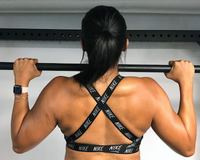
Donkey Calf Raises
When it comes to calf training, most people perform some variation of the standing calf raise. However, the donkey calf raise is performed in a bent over position. This exercise can take your calf training to the next level and help you optimize your lower body workout!
Muscles Worked By The Donkey Calf Raise
Primary Muscle Groups:
The donkey calf raise primarily engages the two muscles that make up the calves: the gastrocnemius and the soleus. Comprised of two heads, the gastrocnemius sits above the soleus and is the larger of the two muscles.
Together, the gastroc-soleus complex acts to pull the heel upwards to aid in walking, running, and other movements.

Secondary Muscle Groups:
The donkey calf raise secondarily activates the hamstrings and abs. When you bend over to initiate the calf raise, the hamstrings receive a stretch. In addition, the transverse abdominis and rectus abdominis activate to stabilize your mid section.
Donkey Calf Raise Benefits
1. Strength Gains
Unlike standing calf raises, the donkey calf raise targets the calf muscle from a stretched position. This greatly increases calf muscle activation during the exercise motion. Whether you are an athlete, bodybuilder, or simply someone who values fitness, this exercise will certainly help you build stronger calves.
2. Size Gains
For most people, building bigger calves can be extremely difficult. Thankfully, when compared to the standing calf raise, donkey calf raises better activate the gastrocnemius, the larger of the two calf muscles. In order to maximize the size of your calves, perform a high volume of donkey calf raises in a slow, controlled fashion.
3. Improved Vertical Jump And Speed
Your calves activate significantly during the running and jumping motions, as they are the closest muscles to the ground that aid in explosiveness. Their development is crucial to the process of improving your vertical jump and your sprinting speed. Doing donkey calf raises can provide an added bonus of improving your athletic performance.
How To Do The Donkey Calf Raise
Equipment:
A step platform or plate and another stable object (bench, chair, railing, etc.) at waist height.
Setup:
a) Position the platform or plate a few feet in front of the waist high object.
b) Step up onto the near edge of the platform/weight and hinge at the waist to bend over and hold onto the elevated object. Your back should be roughly parallel to the ground.
Action:
a) Engage your core and slowly lower your heels towards the floor.
b) Contract your calves to raise up onto your toes. Squeeze your calves hard in this position and pause for a moment.
c) Slowly return to the starting position and repeat for the desired number of reps.

Recommendation:
In order to maximize your calf gains, aim to complete anywhere from 15 to 25 repetitions for 3-4 sets of the donkey calf raise.
Common Donkey Calf Raise Mistakes
1. Completing Partial Reps
Far too often, I see weight lifters performing the donkey calf raise by “pulsing” up and down on their toes. This pulsing motion is a partial rep! Instead, slowly raise all the way up onto your toes and squeeze your calves hard at the top.
Then, drop your heels all the way to the floor and mindfully contract your calves once again to perform another complete repetition.
2. Standing Too Upright
Another common mistake made during the donkey calf raise is standing too upright. This mistake removes the stretch in your calves during the exercise motion, which minimizes your gains. Try to keep your back nearly parallel to the ground and make sure you feel a stretch in your calves before completing each rep.
Donkey Calf Raise Variations
1. Weighted Donkey Calf Raise
You can also add resistance to the donkey calf raise. Secure a weight belt around your waist and add on a comfortable amount of weight. Then, complete the exercise with the same form as the bodyweight donkey calf raise.

2. Donkey Calf Raise Machine
The donkey calf raise machine can help to simplify this exercise. First, load on a comfortable amount of weight. Then, step on the foot plate, hinge at the waist, and situate the upper pad on your lower back.
From this position, contract your calves to lift up on your toes. Squeeze your calves hard at the top and slowly return to the starting position. Repeat!

Donkey Calf Raise Alternatives
If you enjoyed the donkey calf raise, check out these alternative calf exercises to bolster your lower body training:
1. Upright Stretcher Lifts
Assume a standing position with your feet close together. Bend at the waist to lean over and point your hands towards the ground. You should feel a stretch in your calves.
Then, contract your calves to lift up on your toes. Squeeze your calves hard at the top and slowly return to the starting position. Repeat!

2. Seated Dumbbell Calf Raises
The seated calf raise works your soleus more than your gastrocnemius. Assume a seated position on the edge of a bench or chair. Engage your core and keep your back straight. Place two dumbbells vertically on top of your knees and contract your calves to rise up on your toes.
Squeeze your calves hard at the top and slowly return to the starting position. Repeat!

3. Calf Squats
Assume a standing position with your feet shoulder width apart. Keeping your core engaged and your back straight, squat down until your hips are in line with your knees.
Then, transition weight onto your toes at the bottom of the squat and drive upwards through your calves. Repeat!

Looking For A Full Calf Workout?
You don’t need any fancy equipment or expensive gym memberships to train your calves.
Follow along to this five minute calf workout routine right from home!
Join The Invasion!
This Anabolic Aliens membership will grant you access to workout classes, rehab programs, diet plans, and more exclusive content to help you achieve sustainable success!










